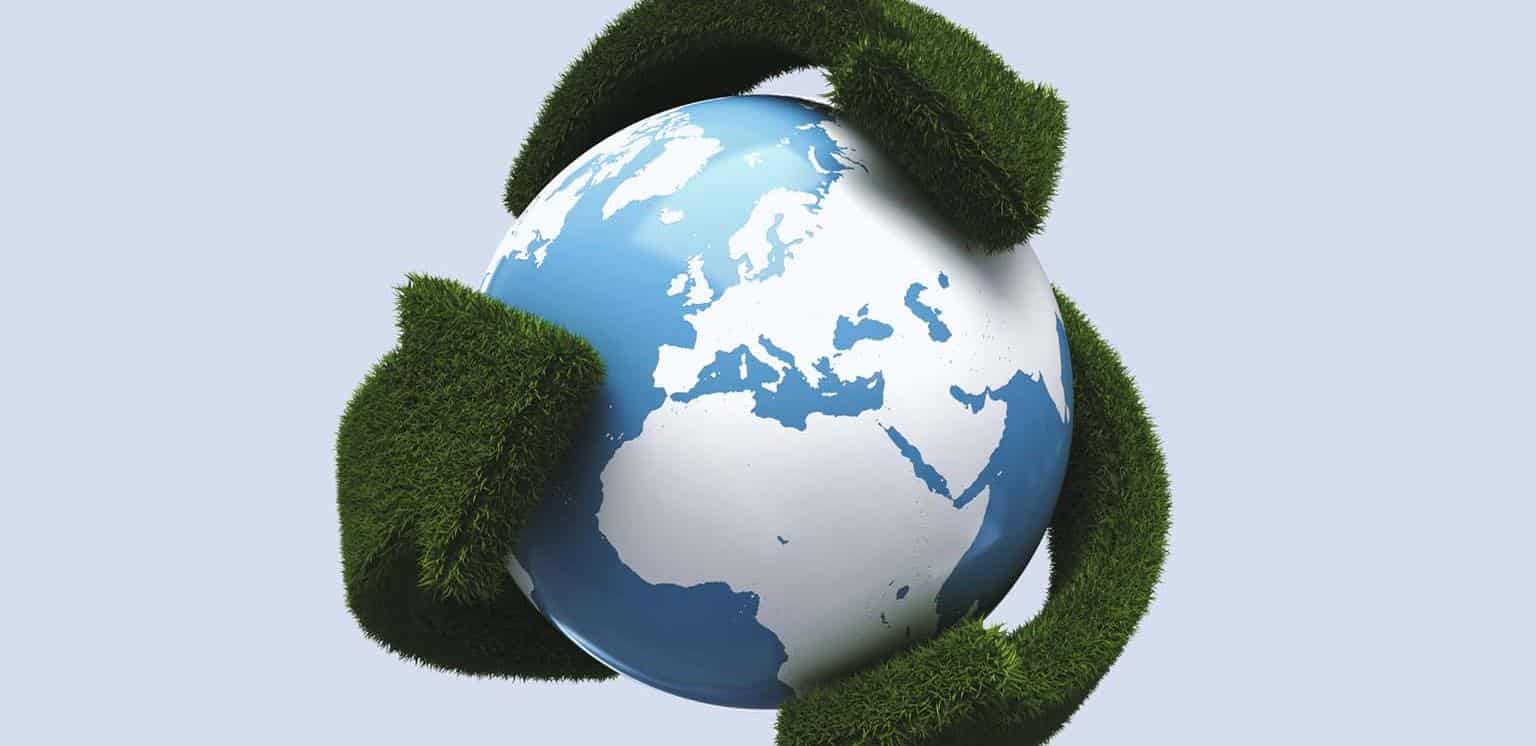Sustainability regulations for packaging have become increasingly ambitious. A detailed understanding of the diverse regulatory landscape will be essential for companies to remain compliant.
Sustainability in packaging is a megatrend shaping the packaging industry, with consumers becoming increasingly worried about the environment and the impact of packaging leakage. In response, new, stricter sustainability regulations are emerging on multiple fronts with increasing frequency. However, regulatory focus and approaches vary considerably by region and diverge even further when viewed at the country or state level. This heterogeneity is making the fast-changing regulatory landscape complex to navigate on a worldwide basis. To better understand the recent developments, we have mapped regulations in 30 countries around the world. Our findings reveal several common patterns of development that can be represented by four archetypes globally. To ensure they comply with the evolving requirements, packaging companies should stay tuned to regulation developments in sustainability packaging by tracking changes in their focus markets and implement processes to address future requirements proactively.
Increasing pace of regulatory development
Pressure to reduce packaging waste has increased dramatically in the face of global consumer sentiment aroused by visceral images of packaging leakage into oceans (Exhibit 1)—and regulators are responding to address the public outcry. In recent years, we have seen a rapid increase in sustainable-packaging regulations well beyond a focus on shopping bags and selective food-service items. It is critical for companies across the packaging value chain to be aware of the accelerating pace of regulatory development, as noncompliance could lead to the imposition of tax increases or penalties. However, understanding the developing regulations on a global scale is highly complex given the following factors:
- Regulatory maturity across countries is extremely heterogeneous.
- Established or aligned terminology is not in place globally—for example, the term recycling can have different meanings, leading to variable intensity of impact for the industry.
- What is in scope varies. For example, some regulations are focused on multiple categories, applications, end products, and materials, while others focus on specific aspects—this creates potential overlap with different regulations covering a similar scope.
- Regulations are still in early stages of development, leading to uncertainty around undefined scopes, action plans, or targets.
- The geographical picture is complicated, as regulations can be developed at a federal, state, or even city level.
Exhibit 1
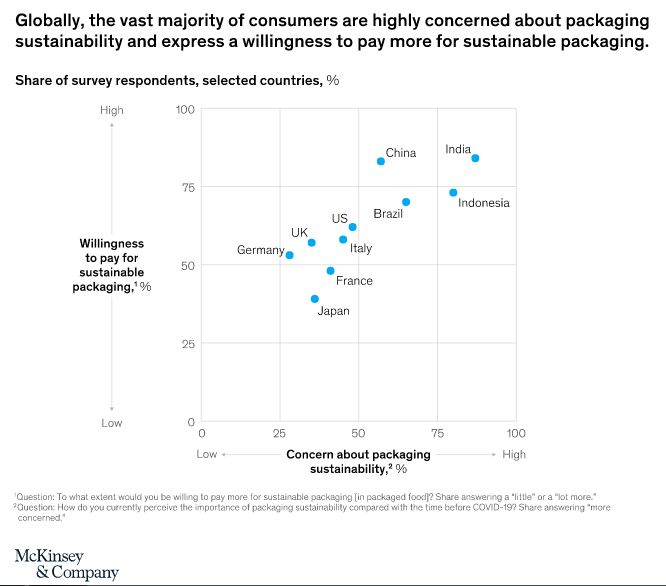
In recent years, we have seen a rapid increase in sustainable-packaging regulations well beyond a focus on shopping bags and selective food-service items.
To better understand the developing picture, we have mapped current and proposed regulations in 30 countries around the world. This covers all regions: Europe and the European Union (eight countries), North America (three countries), Latin America (four countries), Asia (seven countries), and the Middle East and Africa (eight countries).
Mapping regulatory development across 30 countries
It is clear that there has been a general awakening on the issue given that 29 out of 30 countries studied have started to discuss and implement sustainable-packaging regulations. As expected, these regulations are intended to enforce new requirements with the principal aim of limiting the negative impact of packaging on both the environment and on human health. Most regulations across the countries studied also tackle the following end-to-end elements:
- packaging specifications (such as composition, size, and weight)
- attributes of packaging (for example, recyclability and biodegradability)
- expected primary use of packaging (for example, labeling and traceability to promote customer empowerment)
- packaging chain, from raw-materials sourcing to disposal, including collection and sorting schemes and reuse or recycling target setting
Countries have mostly embarked on their sustainability journey by addressing the start and the end of the flow—that is, the restriction of certain materials and a focus on waste management via extended producer responsibility (EPR). More advanced countries have set up infrastructure to support lasting changes in design, recycling capabilities, and recycled-content use (Exhibit 2):
- Twenty-eight out of 30 countries have collection, sorting, and EPR schemes and regulations in place or in development.
- More than 40 percent of the 30 countries studied already have an EPR scheme in place.
Exhibit 2
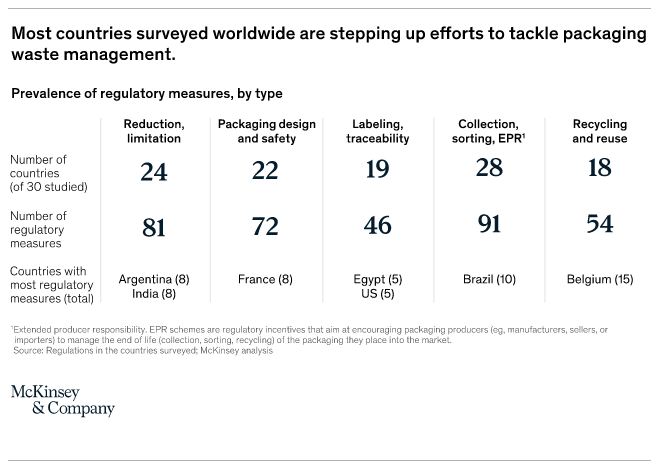
Packaging-waste management is subject to the highest number of regulatory measures worldwide (91 in total). In addition, there has been an increasing regulatory focus on more specific areas of packaging, including the following:
Plastic packaging. In the past three years, sustainable-packaging regulations have tended to focus primarily on plastic packaging (versus other substrates). Eighty-three percent of the legal measures relating to sustainable packaging worldwide focus on plastics—with a total of 147 measures identified. The European Union and Asia have the highest number of regulations focusing on plastics, with France and India being the top countries in this respect.
Beverage packaging. Regulations worldwide tend to have a relatively higher focus on beverage packaging than on other categories such as food and home personal-care packaging. However, there are noticeable regional differences:
- The European Union and North America focus more on beverages, with 50 to 60 percent of their regulatory measures having a specific end-product scope targeting beverages.
- Latin America and the Middle East focus more on food packaging.
- In the European Union and Asia, an emerging trend aims to tackle packaging across multiple product categories, reflecting a more holistic approach beyond a single focus area (such as beverages) to encompass a broader spectrum of end-use areas.
Primary versus secondary packaging. Regulations tend to focus on primary packaging all over the world, but a focus on secondary and tertiary packaging1 is more prevalent in Asia:
- Worldwide, nearly 90 percent of legal measures with a specific scope of packaging type tackle primary packaging alone or together with other packaging types (secondary, tertiary).
- China, India, Vietnam, and the Philippines are proposing regulatory measures that focus on secondary and tertiary packaging, while India has the most measures focusing on secondary and tertiary packaging. China has also shown an increasing focus on regulations around e-commerce packaging to minimize waste and leakage.
Regulatory vehicle for change. Our mapping reveals that financial penalties (versus subsidies) represent the main and preferred regulatory vehicle for sustainability change in the packaging industry: approximately 45 percent of legal measures implying a defined financial fallout refer to penalties—and these are generally related to taxes, fines, and fees. France uses incentives the most to encourage change in packaging sustainability (for example, via indirect premiums or indirect subsidies/funding2 ).
Four archetypes identified
Most countries are moving toward setting up regulations around sustainable packaging, though at different paces and in various depths (Exhibit 3).
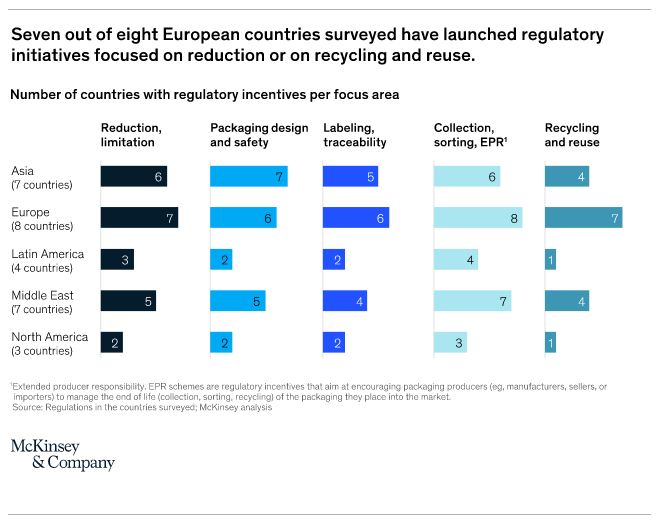
Exhibit 4
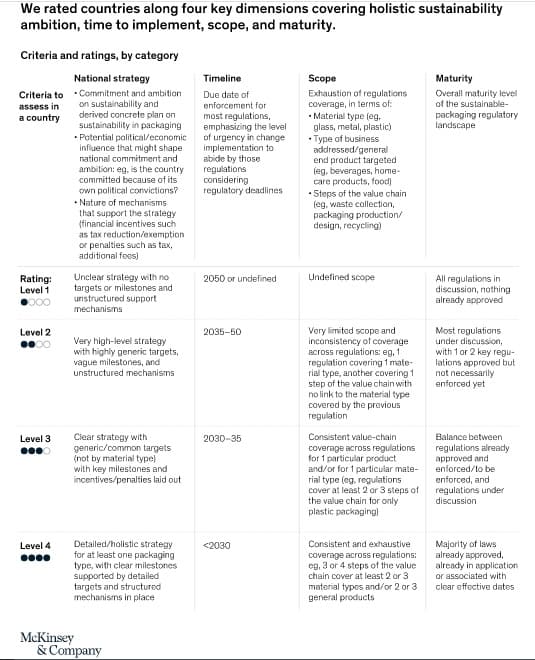
This mapping and rating of national strategy has enabled us to categorize the world according to four archetypes, from the least mature countries to the leading countries—those that are defining what sustainable packaging means.
This mapping and rating of national strategy has enabled us to categorize the world according to four archetypes.
Archetype 1. Unclear strategy with no targets or milestones and unstructured mechanisms to support sustainable packaging. This archetype (seven of the 303 countries we mapped, mainly located in North Africa, the Middle East and Southeast Asia) represents countries with limited regulations on this topic and where sustainable packaging is not the principal concern. Regulations have started to emerge in these countries, but they focus mainly on packaging-waste management. These countries typically do not present a holistic regulatory picture of packaging sustainability.
Archetype 2. Very high-level strategy with mostly generic targets, vague milestones, and unstructured mechanisms. This group represents countries in the early stages of sustainable-packaging regulation, mostly in the Americas. Their regulations are very immature, with numerous regulatory initiatives still under discussion or needing significant clarification and translation into more practical and concrete measures. Although they have demonstrated some willingness to make progress, the paths these countries will follow remain unclear. This category comprises seven countries.
Archetype 3. Clear strategy with generic/common targets (not by material type), with defined key milestones, incentives, and penalties. This archetype represents countries with a very recent but strong regulatory commitment to shaping the packaging industry in a more sustainable way. Prompted by business and public concerns, these countries have already started to define concrete plans of action and supporting measures. Eight mostly European and Asian countries comprise this archetype.
Archetype 4. Detailed, holistic strategy for at least one packaging type, with clear milestones supported by detailed targets, and structured mechanisms in place. This group comprises countries with developed economies and a very high packaging consumption, with market growth rates that tend to be slowing. Environmental considerations are not novel within the regulatory context of these countries. There is an advanced regulatory landscape covering packaging sustainability (for example, detailed target setting for recycling, as well as concrete incentives and penalties to support regulatory objectives). Seven of the 30 countries studied are in this archetype. This group consists mainly of European countries and a small number of countries in Southern Africa and Asia.
This national strategy ranking indicates that 40 percent of countries have high ambitions to take concrete actions, supported by a clear set of targets, by 2030. The remaining countries are committed to longer timelines and looser initiatives, or even lack visibility.
The constant evolution of regulation will require packaging value-chain companies to keep track of changes in order to remain compliant.
Questions to ask to stay up to date on development
The constant evolution of regulation will require packaging value-chain companies to keep track of changes in order to remain compliant. At the same time, they will need to develop capabilities to acquire an in-depth understanding of regulatory measures, scope, and application—as well as the implications for their own business and customers. This will also be important from an investment perspective. To get started, we propose three critical questions for packaging companies to consider:
- Do we have a market intelligence taskforce in place within the organization to keep track of regulatory changes in our focus markets and to understand what other players along the value chain are doing?
- Do we have agile processes in place internally to address current and future regulatory requirements quickly, and will we be able to change or adapt our business model in order to comply with the regulations?
- What product- and technology-level investments should we be making regarding packaging as part of product sustainability? Here, it will be important to identify whether new packaging products will need to be developed to comply with the regulatory requirements (and if these products need to be differentiated for specific countries or focus markets). It will also be important to identify partnering opportunities for circular recycling, including renewable materials.
The sustainability regulation landscape is becoming ever more complex. The number of regulations, and the speed in which they can become effective, is increasing fast. In addition, 75 percent of the 30 countries mapped have implemented or intend to put in place penalties for regulatory noncompliance. A granular understanding of the regulations, therefore, is a must-have for all organizations along the packaging value chain.
McKinsey & Company McKinsey & Company is a global management consulting firm, deeply committed to helping institutions in the private, public, and social sectors achieve lasting success. For more than 90 years, our primary objective has been to serve as our clients’ most trusted external adviser. With consultants in more than 100 cities in over 60 markets, across industries and functions, we bring unparalleled expertise to clients all over the world. We work closely with teams at all levels of an organization to shape winning strategies, mobilize for change, build capabilities, and drive successful execution.

